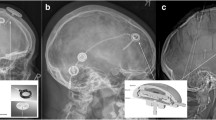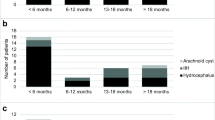Abstract
Introduction
Ventriculoperitoneal (VP) shunt is the primary therapy for hydrocephalus in children; however, this technique is amenable to malfunctions, which could be detected through an assessment of clinical signs and imaging results. Furthermore, early detection can prevent patient deterioration and guide clinical and surgical treatment.
Case presentation
A 5-year-old female with a premedical history of neonatal IVH, secondary hydrocephalus, multiple VP shunts revisions, and slit ventricle syndrome was evaluated using a noninvasive intracranial pressure monitor device at the early stages of the clinical symptoms, evidencing increased intracranial pressure and poor brain compliance. Serial MRI images demonstrated a slight ventricular enlargement, leading to the use of a gravitational VP shunt, promoting progressive improvement. On the follow-up visits, we used the noninvasive ICP monitoring device to guide the shunt adjustments until symptom resolution. Furthermore, the patient has been asymptomatic for the past 3 years without requiring new shunt revisions.
Discussion
Slit ventricle syndrome and VP shunt dysfunctions are challenging diagnoses for the neurosurgeon. The noninvasive intracranial monitoring has allowed a closer follow-up assisting early assessment of brain compliance changes related to a patient's symptomatology. Furthermore, this technique has high sensitivity and specificity in detecting alterations in the intracranial pressure, serving as a guide for the adjustments of programmable VP shunts, which may improve the patient's quality of life.
Conclusion
Noninvasive ICP monitoring may lead to a less invasive assessment of patients with slit ventricle syndrome and could be used as a guide for adjustments of programmable shunts.



Similar content being viewed by others
Data availability
Data from this manuscript are available upon reasonable request.
References
Mazzola CA, Choudhri AF, Auguste KI, Limbrick DD, Rogido M Jr, Mitchell L, Flannery AM (2014) Pediatric hydrocephalus: systematic literature review and evidence-based guidelines. Part 2: Management of posthemorrhagic hydrocephalus in premature infants. J Neurosurg Pediatr 14(Suppl 1):8–23
Nag DS, Sahu S, Swain A, Kant S (2019) Intracranial pressure monitoring: gold standard and recent innovations. World J Clin Cases 7:1535–1553
Roumeliotis N, Pettersen G, Crevier L, Émeriaud G (2015) ICP monitoring in children: why are we not adhering to guidelines? Childs Nerv Syst 31:2011–2014
Xu W, Gerety P, Aleman T, Swanson J, Taylor J (2016) Noninvasive methods of detecting increased intracranial pressure. Childs Nerv Syst 32:1371–1386
Jayanth A, Benabbas R, Chao J, Sinert R (2021) Diagnostic modalities to determine ventriculoperitoneal shunt malfunction: a systematic review and meta-analysis. Am J Emerg Med 39:180–189
Aralar A, Bird M, Graham R, Koo B, Chitnis P, Sikdar S, Shenai M (2018) Assessment of ventriculoperitoneal shunt function using ultrasound characterization of valve interface oscillation as a proxy. Cureus 10:e2205
Ballestero MFM, Frigieri G, Cabella BCT, de Oliveira SM, de Oliveira RS (2017) Prediction of intracranial hypertension through noninvasive intracranial pressure waveform analysis in pediatric hydrocephalus. Childs Nerv Syst 33:1517–1524
Auricchio AM, Bohnen A, Nichelatti M, Cenzato M, Talamonti G (2021) Management of slit ventricle syndrome: a single-center case series of 32 surgically treated patients. World Neurosurg
Paff M, Alexandru-Abrams D, Muhonen M, Loudon W (2018) Ventriculoperitoneal shunt complications: a review. Interdisciplinary Neurosurgery 13:66–70
Hawryluk GWJ, Citerio G, Hutchinson P, Kolias A, Meyfroidt G, Robba C, Stocchetti N, Chesnut R (2022) Intracranial pressure: current perspectives on physiology and monitoring. Intensive Care Med 48:1471–1481
Rekate HL (2008) Shunt-related headaches: the slit ventricle syndromes. Childs Nerv Syst 24:423–430
Engel M, Carmel PW, Chutorian AM (1979) Increased intraventricular pressure without ventriculomegaly in children with shunts: “normal volume” hydrocephalus. Neurosurgery 5:549–552
Kazimierska A, Kasprowicz M, Czosnyka M, Placek MM, Baledent O, Smielewski P, Czosnyka Z (2021) Compliance of the cerebrospinal space: comparison of three methods. Acta Neurochir (Wien) 163:1979–1989
Mascarenhas S, Vilela GH, Carlotti C, Damiano LE, Seluque W, Colli B, Tanaka K, Wang CC, Nonaka KO (2012) The new ICP minimally invasive method shows that the Monro-Kellie doctrine is not valid. Acta Neurochir Suppl 114:117–120
Paraguassu G, Khilnani M, Rabelo NN, Cobos LD, Frigieri G (2021) Case report: untreatable headache in a child with ventriculoperitoneal shunt managed by use of new non-invasive intracranial pressure waveform. Front Neurosci 15:601945
de AP Andrade R, Oshiro HE, Miyazaki CK, Hayashi CY, de Morais MA, Brunelli R, Carmo JP (2021) A nanometer resolution wearable wireless medical device for non invasive intracranial pressure monitoring. IEEE Sens J 21:22270–22284
Author information
Authors and Affiliations
Contributions
N.Z., V.B., T.H., G.C., neurosurgical experts, wrote the case. C.H. and G.F. wrote the manuscript (technical device knowledge). V.B. English language review. V.B. and C.H. prepared the figures. All authors reviewed the manuscript.
Corresponding author
Ethics declarations
Ethics approval
This case report was approved by the local ethics committee (CAAE: 31589920.7.3001.5487—Protocol #4.860.944/2021) in compliance with the Declaration of Helsinki.
Consent to participate
Written informed consent was given by the patient's legal guardian regarding the publication of images and clinical data included in this report.
Conflict of interest
NZ has nothing to declare. VHCB has nothing to declare. TH has nothing to declare. CYH declares personal fees as employee (Clinical Research Nurse) from Braincare Desenvolvimento e Inovação Tecnológica S.A. during the conduct of this study. GF declares personal fees as an employee (Scientific Director) from Braincare Desenvolvimento e Inovação Tecnológica S.A. during this study. In addition, GF has a patent US9826934B2 issued and a patent US9993170B1 issued. GC has nothing to declare.
Additional information
Publisher's Note
Springer Nature remains neutral with regard to jurisdictional claims in published maps and institutional affiliations.
Rights and permissions
Springer Nature or its licensor (e.g. a society or other partner) holds exclusive rights to this article under a publishing agreement with the author(s) or other rightsholder(s); author self-archiving of the accepted manuscript version of this article is solely governed by the terms of such publishing agreement and applicable law.
About this article
Cite this article
Zanon, N., da Costa Benalia, V.H., Hoesker, T. et al. Noninvasive intracranial pressure monitoring throughout brain compliance guiding a ventriculoperitoneal shunt replacement in hydrocephalus—case report. Childs Nerv Syst 39, 2215–2219 (2023). https://doi.org/10.1007/s00381-023-05922-3
Received:
Accepted:
Published:
Issue Date:
DOI: https://doi.org/10.1007/s00381-023-05922-3




